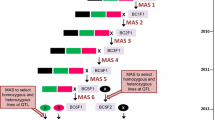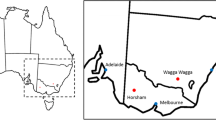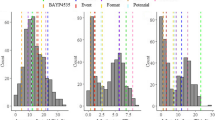Abstract
Partial resistances, often controlled by quantitative trait loci (QTL), are considered to be more durable than monogenic resistances. Therefore, a precursor to developing efficient breeding programs for polygenic resistance to pathogens should be a greater understanding of genetic diversity and stability of resistance QTL in plants. In this study, we deciphered the diversity and stability of resistance QTL to Aphanomyces euteiches in pea towards pathogen variability, environments and scoring criteria, from two new sources of partial resistance (PI 180693 and 552), effective in French and USA infested fields. Two mapping populations of 178 recombinant inbred lines each, derived from crosses between 552 or PI 180693 (partially resistant) and Baccara (susceptible), were used to identify QTL for Aphanomyces root rot resistance in controlled and in multiple French and USA field conditions using several resistance criteria. We identified a total of 135 additive-effect QTL corresponding to 23 genomic regions and 13 significant epistatic interactions associated with partial resistance to A. euteiches in pea. Among the 23 additive-effect genomic regions identified, five were consistently detected, and showed highly stable effects towards A. euteiches strains, environments, resistance criteria, condition tests and RIL populations studied. These results confirm the complexity of inheritance of partial resistance to A. euteiches in pea and provide good bases for the choice of consistent QTL to use in marker-assisted selection schemes to increase current levels of resistance to A. euteiches in pea breeding programs.




Similar content being viewed by others
References
Baker RJ, McKenzie RIH (1967) Use of control plots in yield trials. Crop Sci 7:335–337
Blanc G, Charcosset A, Mangin B, Gallais A, Moreau L (2006) Connected populations for detecting quantitative trait loci and testing for epistasis: an application in maize. Theor Appl Genet 113:206–224
Bourion V, Rizvi SMH, Fournier S, de Larambergue H, Galmiche F, Marget P, Duc G, Burstin J (2010) Genetic dissection of nitrogen nutrition in pea through a QTL approach of root, nodule, and shoot variability. Theor Appl Genet 121:71–86
Brun H, Chèvre AM, Fitt BDL, Powers S, Besnard AL, Ermel M, Huteau V, Marquer B, Eber F, Renard M, Andrivon D (2010) Quantitative resistance increases the durability of qualitative resistance to Leptosphaeria maculans in Brassica napus. New Phytol 185:285
Buerstmayr H, Bant T, Anderson JA (2009) QTL mapping and marker-assisted selection for Fusarium head blight resistance in wheat: a review. Plant Breed 128:1–26
Burstin J, Marget P, Huart M, Moessner A, Mangin B, Duchene C, Desprez B, Munier-Jolain N, Duc G (2007) Developmental genes have pleiotropic effects on plant morphology and source capacity, eventually impacting on seed protein content and productivity in pea. Plant Physiol 144:768–781
Caffier V, Laurens F (2005) Breakdown of Pl2, a major gene of resistance to apple powdery mildew, in a French experimental orchard. Plant Pathol 54:116–124
Castagnone-Sereno P (2002) Genetic variability in parthenogenetic root-knot nematodes, Meloidogyne spp., and their ability to overcome plant resistance genes. Nematologica 4:605–608
Dagnelie P (2003) Principes d’expérimentation: planification des expériences et analyse de leurs résultats. Gembloux, Presses agronomiques, p 397
Davis DW, Fritz VA, Pfleger FL, Percich JA, Malvick DK (1995) MN 144, MN 313, and MN 314: garden pea lines resistant to root rot caused by Aphanomyces euteiches Drechs. Hortic Sci 30:639–640
De Givry S, Bouchez M, Chabrier P, Milan D, Schiex T (2005) CAR(H)(T)AGene: multipopulation integrated genetic and radiation hybrid mapping. Bioinformatics 21:1703–1704
Deulvot C, Charrel H, Marty A, Jacquin F, Donnadieu C, Lejeune-Henaut I, Burstin J, Aubert G (2010) Highly-multiplexed SNP genotyping for genetic mapping and germplasm diversity studies in pea. BMC Genomics 11:468
Doyle JJ, Doyle JL (1990) Isolation of plant DNA from fresh tissue. Focus 12:13–15
Duparque M, Boitel C (2001) Common root rot (Aphanomyces euteiches) reduces the yield of pea (Pisum sativum L.) depending on the resistance level of the genotype. In: Proceedings of the 4th European conference on grain legumes, 8–12 July 2001, Cracow, Poland, pp 270–271
Ellis THN, Poyser SJ (2002) An integrated and comparative view of pea genetic and cytogenetic maps. New Phytol 153:17–25
Ender M, Terpstra K, Kelly JD (2008) Marker-assisted selection for white mold resistance in common bean. Mol Breed 21:149–157
Faleiro FG, Ragagnin VA, Moreira MA, de Barros EG (2004) Use of molecular markers to accelerate the breeding of common bean lines resistant to rust and anthracnose—breeding of common bean lines resistant to rust and anthracnose aided by molecular markers. Euphytica 138:213–218
Gaulin E, Madoui MA, Bottin A, Jacquet C, Mathe C, Couloux A, Wincker P, Dumas B (2008) Transcriptome of Aphanomyces euteiches: new oomycete putative pathogenicity factors and metabolic pathways. PLoS ONE 3:e1723
Gaulin E, Madoui MA, Larroque M, Bottin A, Dumas B (2010) Identification de nouveaux effecteurs et voies métaboliques d’oomycètes par analyse génomique d’Aphanomyces euteiches. 8èmes Rencontres de Phytopathologie—Mycologie de la Société Française de Phytopathologie, 25–29 January 2010, Aussois, France
Gritton ET (1990) Registration of five root rot resistant germplasm lines of processing pea. Crop Sci 30:1167
Gritton ET (1995) Offer of seed from the Earl Gritton pea improvement program at Madison. Pisum Genet 27:29–30
Gutierrez MV, Vaz Patto MC, Huguet T, Cubero JI, Moreno MT, Torres AM (2005) Cross-species amplification of Medicago truncatula microsatellites across three major pulse crops. Theor Appl Genet 110:1210–1217
Hamon C, Baranger A, Miteul H, Lecointe R, Le Goff I, Deniot G, Onfroy C, Moussart A, Prosperi JM, Tivoli B, Delourme R, Pilet Nayel ML (2010) A complex genetic network involving a broad-spectrum locus and strain specific loci controls resistance to different pathotypes of Aphanomyces euteiches in Medicago truncatula. Theor Appl Genet 120:955–970
Hanocq E, Laperche A, Jaminon O, Laine AL, Le Gouis J (2007) Most significant genome regions involved in the control of earliness traits in bread wheat, as revealed by QTL meta-analysis. Theor Appl Genet 114:569–584
Hospital F (2009) Challenges for effective marker-assisted selection in plants. Genetica 136:303–310
Jourjon MF, Jasson S, Marcel J, Ngom B, Mangin B (2005) MCQTL: multi-allelic QTL mapping in multi-cross design. Bioinformatics 21:128–130
Kou YJ, Wang SP (2010) Broad-spectrum and durability: understanding of quantitative disease resistance. Curr Opin Plant Biol 13:181–185
Kousik CS, Ritchie DF (1998) Response of bell pepper cultivars to bacterial spot pathogen races that individually overcome major resistance genes. Plant Dis 82:181–186
Kraft JM (1992) Registration of 90-2079, 90-2131, and 90-2322 pea germplasms. Crop Sci 32:1076
Kraft JM, Coffman VA (2000a) Registration of 96-2052, 96-2058, 96-2068, 96-2198, and 96-2222 pea germplasms. Crop Sci 40:301–302
Kraft JM, Coffman VA (2000b) Registration of 97-261 and 97-2154 pea germplasms. Crop Sci 40:302–303
Kraft JM, Coffman VA (2000c) Registration of 97-363, 97-2170, and 97-2162 pea germplasms. Crop Sci 40:303
Lander ES, Green P, Abrahamson J, Barlow A, Daly M, Lincoln S, Newberg L (1987) MAPMAKER: an interactive computer package for constructing primary genetic linkage maps of experimental and natural populations. Genomics 1:174–181
Laucou V, Haurogné K, Ellis N, Rameau C (1998) Genetic mapping in pea. 1. RAPD-based genetic linkage map of Pisum sativum. Theor Appl Genet 97:905
Lejeune-Henaut I, Hanocq E, Bethencourt L, Fontaine V, Delbreil B, Morin J, Petit A, Devaux R, Boilleau M, Stempniak JJ, Thomas M, Laine AL, Foucher F, Baranger A, Burstin J, Rameau C, Giauffret C (2008) The flowering locus Hr colocalizes with a major QTL affecting winter frost tolerance in Pisum sativum L. Theor Appl Genet 116:1105–1116
Lewis ME, Gritton ET (1988) Improving resistance to Aphanomyces root rot in peas via recurrent selection. PNL 20:20–21
Lewis ME, Gritton ET (1992) Use of one cycle of recurrent selection per year for increasing resistance to Aphanomyces root rot in peas. J Am Soc Hort Sci 117:638–642
Liao CY, Wu P, Hu B, Yi KK (2001) Effects of genetic background and environment on QTLs and epistasis for rice (Oryza sativa L.) panicle number. Theor Appl Genet 103:104
Lincoln S, Daly M, Lander ES (1992) Constructing genetic maps with MAPMAKER/EXP 3.0. Whitehead Institute Technical Report, 3rd edn, Whitehouse Technical Institute, Cambridge
Lockwood JL (1960) Pea introductions with partial resistance to Aphanomyces root rot. Phytopathology 50:621–624
Loridon K, McPhee K, Morin J, Dubreuil P, Pilet-Nayel ML, Aubert G, Rameau C, Baranger A, Coyne C, Lejeune-Hénaut I, Burstin J (2005) Microsatellite marker polymorphism and mapping in pea (Pisum sativum L.). Theor Appl Genet 111:1022–1031
Macas J, Neumann P, Navratilova A (2007) Repetitive DNA in the pea (Pisum sativum L.) genome: comprehensive characterization using 454 sequencing and comparison to soybean and Medicago truncatula. BMC Genomics 8:427
Madoui MA, Gaulin E, Mathe C, San Clemente H, Couloux A, Wincker P, Dumas B (2007) AphanoDB: a genomic resource for Aphanomyces pathogens. BMC Genomics 8:471
Malvick DK, Percich JA (1999) Identification of Pisum sativum germplasm with resistance to root rot caused by multiple strains of Aphanomyces euteiches. Plant Dis 83:51–54
Malvick DK, Grau CR, Percich JA (1998) Characterization of Aphanomyces euteiches strains based on pathogenicity tests and random amplified polymorphic DNA analyses. Mycol Res 102:465–475
Marx GA, Schroeder WT, Provvidenti R, Mishanec W (1972) A genetic study of tolerance in pea (Pisum sativum L.) to Aphanomyces root rot. J Am Soc Hort Sci 97(5):619–621
Moussart A, Wicker E, Duparque M, Rouxel F (2001) Development of an efficient screening test for pea resistance to Aphanomyces euteiches. In: 4th European conference on grain legumes, Cracow, pp 272–273
Moussart A, Onfroy C, Lesné A, Esquibet M, Grenier E, Tivoli B (2007) Host status and reaction of Medicago truncatula accessions to infection by three major pathogens of pea (Pisum sativum) and alfalfa (Medicago sativa). Eur J Plant Pathol 117:57–69
Moussart A, Wicker E, Delliou B, Abelard JM, Esnault R, Lemarchand E, Rouault F, Le Guennou F, Pilet-Nayel ML, Baranger A, Rouxel F, Tivoli B (2009) Spatial distribution of Aphanomyces euteiches inoculum in a naturally infested pea field. Eur J Plant Pathol 123:153–158
Palloix A, Ayme V, Moury B (2009) Durability of plant major resistance genes to pathogens depends on the genetic background, experimental evidence and consequences for breeding strategies. New Phytol 183:190–199
Parlevliet JE (2002) Durability of resistance against fungal, bacterial and viral pathogens; present situation. Euphytica 124:147–156
Pfender WF, Malvick DK, Pfleger FL, Grau CR (2001) Aphanomyces root rot. In: Kraft JM, Pfleger FL (eds) Compendium of pea diseases and pests, 2nd edn. APS Press, St. Paul, pp 9–13
Pilet-Nayel ML, Muehlbauer FJ, McGee RJ, Kraft JM, Baranger A, Coyne CJ (2002) Quantitative trait loci for partial resistance to Aphanomyces root rot in pea. Theor Appl Genet 106:28–39
Pilet-Nayel ML, Muehlbauer FJ, McGee RJ, Kraft JM, Baranger A, Coyne CJ (2005) Consistent quantitative trait loci in pea for partial resistance to Aphanomyces euteiches isolates from the United States and France. Phytopathology 95:1287–1293
Pilet-Nayel ML, Coyne C, Hamon C, Lesné A, Le Goff I, Esnault R, Lecointe R, Roux-Duparque M, McGee R, Mangin P, McPhee K, Moussart A, Baranger A (2007) Understanding genetics of partial resistance to Aphanomyces root rot in pea for new breeding prospects. In: Third international Aphanomyces workshop on legumes, 07–09 November 2007, Rennes, France, p 36
Pilet-Nayel ML, Prosperi JM, Hamon C, Lesne A, Lecointe R, Le Goff I, Herve M, Deniot G, Delalande M, Huguet T, Jacquet C, Baranger A (2009) AER1, a major gene conferring resistance to Aphanomyces euteiches in Medicago truncatula. Phytopathology 99:203–208
Prioul S, Frankewitz A, Deniot G, Morin G, Baranger A (2004) Mapping of quantitative trait loci for partial resistance to Mycosphaerella pinodes in pea (Pisum sativum L.), at the seedling and adult plant stages. Theor Appl Genet 108:1322–1334
Prioul-Gervais S, Deniot G, Receveur EM, Frankewitz A, Fourmann M, Rameau C, Pilet-Nayel ML, Baranger A (2007) Candidate genes for quantitative resistance to Mycosphaerella pinodes in pea (Pisum sativum L.). Theor Appl Genet 114:971–984
Richardson KL, Vales MI, Kling JG, Mundt CC, Hayes PM (2006) Pyramiding and dissecting disease resistance QTL to barley stripe rust. Theor Appl Genet 113:485–495
Roux-Duparque M, Boitel C, Decaux B, Moussart A, Alamie J, Pilet-Nayel ML, Muel F (2004) Breeding peas for resitance to Aphanomyces root rot : current main outputs of three breeding programmes. In: Proceedings of the 5th European conference on grain legumes, 7–11 June 2004, Dijon, France, p 133
Shehata MA, Pfleger FL (1983) Response of susceptible and moderately resistant pea genotypes to interaction between Rhizoctonia solani and three other stem and root rot pathogens. Plant Dis 67:1146–1148
Sprague SJ, Balesdent MH, Brun H, Hayden HL, Marcroft SJ, Pinochet X, Rouxel T, Howlett BJ (2006a) Major gene resistance in Brassica napus (oilseed rape) is overcome by changes in virulence of populations of Leptosphaeria maculans in France and Australia. Eur J Plant Pathol 114:33–40
Sprague SJ, Marcroft SJ, Hayden HL, Howlett BJ (2006b) Major gene resistance to blackleg in Brassica napus overcome within three years of commercial production in southeastern Australia. Plant Dis 90:190–198
Steele K, Price A, Shashidhar H, Witcombe J (2006) Marker-assisted selection to introgress rice QTLs controlling root traits into an Indian upland rice variety. Theor Appl Genet 112:208
Voorrips RE (2002) MapChart: software for the graphical presentation of linkage maps and QTLs. J Hered 93:77–78
Wang S, Basten CJ, Zeng ZB (2005) Windows QTL Cartographer 2.5., Department of Statistics, North Carolina State University, Raleigh
Weeden NF, McGee R, Grau CR, Muehlbauer FJ (2000) A gene influencing tolerance to common root rot is located on linkage group IV. Pisum Genet 32:53–55
Weeden NF, McGee RJ, Hadwiger L, Murphy RL, Grau CR, Mathre DE, Przyborowski JA, Muehlbauer FJ (2001) Genetic dissection of tolerance to common root rot (Aphanomyces euteiches) and other root pathogens in pea (Pisum sativum). Hortscience 36:457
Wicker E (2001) Diversité des populations françaises d’Aphanomyces euteiches Drechs., agent de la pourriture racinaire du pois: variabilité pathogène et moléculaire. Ph.D. Thesis ENSAR, Rennes, p 178
Wicker E, Rouxel F (2001) Specific behaviour of french Aphanomyces euteiches Drechs. populations for virulence and aggressiveness on pea, related to isolates from Europe, America and New Zealand. Eur J Plant Pathol 107:919–929
Wicker E, Hullé M, Rouxel F (2001) Pathogenic characteristics of isolates of Aphanomyces euteiches from pea in France. Plant Pathol 50:433–442
Wicker E, Moussart A, Duparque M, Rouxel F (2003) Further contributions to the development of a differential set of pea cultivars (Pisum sativum) to investigate the virulence of isolates of Aphanomyces euteiches. Eur J Plant Pathol 109:47–60
Xu YB, Crouch JH (2008) Marker-assisted selection in plant breeding: From publications to practice. Crop Sci 48:391–407
Zeng ZB (1994) Precision mapping of quantitative trait loci. Genetics 136:1457–1468
Acknowledgments
This work was funded by a pre-doctoral fellowship from INRA, Département de Génétique et Amélioration des Plantes (France), MAP (Ministère de l’agriculture et de la pêche, Paris, France) and UNIP (Union Nationale Interprofessionnelle des Plantes riches en protéines, Paris, France), which we greatly acknowledge. It was also supported by the FP6 Grain Legume Integrated Project (FOOD-CT-2004-506223) (GLIP). We thank the INRA experimental units of Le Rheu and Dijon-Epoisses, France, UNILET (Union Nationale Interprofessionnelle des Légumes Transformés), Quimperlé, France, for contributing to field experiments. We also acknowledge the technical staff and students from the Legume group of INRA Le Rheu, France (G. Deniot, J.M. Abelard, J. Poisson, J. Gautier and A. Grenié) for plant material production and field evaluation. We thank the Biogenouest genotyping platform of Le Rheu, France, for technical assistance.
Author information
Authors and Affiliations
Corresponding author
Additional information
Communicated by E. Carbonell.
Electronic supplementary material
Below is the link to the electronic supplementary material.
Rights and permissions
About this article
Cite this article
Hamon, C., Baranger, A., Coyne, C.J. et al. New consistent QTL in pea associated with partial resistance to Aphanomyces euteiches in multiple French and American environments. Theor Appl Genet 123, 261–281 (2011). https://doi.org/10.1007/s00122-011-1582-z
Received:
Accepted:
Published:
Issue Date:
DOI: https://doi.org/10.1007/s00122-011-1582-z




